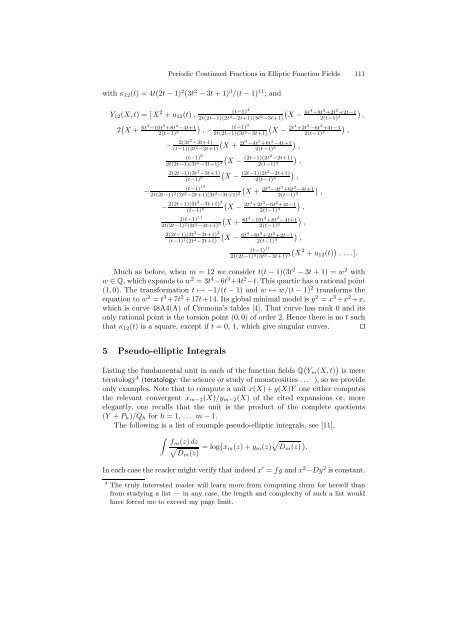Periodic Continued Fractions in Elliptic Function Fields - Macquarie ...
Periodic Continued Fractions in Elliptic Function Fields - Macquarie ...
Periodic Continued Fractions in Elliptic Function Fields - Macquarie ...
You also want an ePaper? Increase the reach of your titles
YUMPU automatically turns print PDFs into web optimized ePapers that Google loves.
<strong>Periodic</strong> <strong>Cont<strong>in</strong>ued</strong> <strong>Fractions</strong> <strong>in</strong> <strong>Elliptic</strong> <strong>Function</strong> <strong>Fields</strong> 111<br />
with κ12(t) =4t(2t − 1) 2 (3t 2 − 3t +1) 3 /(t − 1) 11 ; and<br />
(t−1) 4<br />
2t(2t−1)(2t2−2t+1)(3t2 <br />
6t<br />
−3t+1) X − 4 −8t 3 +2t 2 +2t−1<br />
2(t−1) 3<br />
2 X + 6t4−10t 3 +8t 2 −4t+1<br />
2(t−1) 3<br />
(t−1) 3<br />
2t(2t−1)(3t2 <br />
2t<br />
−3t+1) X − 4 +2t 3 −6t 2 +4t−1<br />
2(t−1) 3<br />
<br />
,<br />
− 2(3t2−3t+1) (t−1)(2t2 <br />
2t<br />
−2t+1) X + 4 −4t 3 +6t 2 −4t+1<br />
2(t−1) 3<br />
<br />
,<br />
Y12(X, t) =[X 2 + u12(t) ,<br />
<br />
, −<br />
−<br />
(t−1) 6<br />
2t(2t−1)(3t2−3t+1) 2<br />
(2t−1)(2t<br />
X − 2 −2t+1)<br />
2(t−1) 3<br />
<br />
,<br />
(2t−1)(2t<br />
X − 2 −2t+1) <br />
,<br />
2(2t−1)(3t 2 −3t+1)<br />
(t−1) 5<br />
2(t−1) 3<br />
(t−1) 10<br />
2t(2t−1) 2 (2t2−2t+1)(3t2−3t+1) 2<br />
<br />
2t X + 4 −4t 3 +6t 2 −4t+1<br />
2(t−1) 3<br />
− 2(2t−1)(3t2−3t+1) 2<br />
(t−1) 8<br />
<br />
2t X − 4 +2t 3 −6t 2 +4t−1<br />
2(t−1) 3<br />
<br />
,<br />
2(t−1) 11<br />
2t(2t−1) 2 (3t2−3t+1) 3<br />
<br />
6t X + 4 −10t 3 +8t 2 −4t+1<br />
2(t−1) 3<br />
<br />
,<br />
2(2t−1)(3t 2 −3t+1) 2<br />
(t−1) 7 (2t 2 −2t+1)<br />
<br />
6t X − 4 −8t 3 +2t 2 +2t−1<br />
2(t−1) 3<br />
(t−1) 11<br />
2t(2t−1) 2 (3t 2 −3t+1) 3<br />
,<br />
<br />
,<br />
2<br />
X + u12(t) ,...].<br />
Much as before, when m =12weconsider t(t − 1)(3t 2 − 3t +1)=w 2 with<br />
w ∈ Q, which expands to w 2 =3t 4 −6t 3 +4t 2 −t. This quartic has a rational po<strong>in</strong>t<br />
(1, 0). The transformation t ↦→ −1/(t − 1) and w ↦→ w/(t − 1) 2 transforms the<br />
equation to w 2 = t 3 +7t 2 +17t+14. Its global m<strong>in</strong>imal model is y 2 = x 3 +x 2 +x,<br />
which is curve 48A4(A) of Cremona’s tables [4]. That curve has rank 0 and its<br />
only rational po<strong>in</strong>t is the torsion po<strong>in</strong>t (0, 0) of order 2. Hence there is no t such<br />
that κ12(t) isasquare, except if t =0,1,which give s<strong>in</strong>gular curves. ⊓⊔<br />
5 Pseudo-elliptic Integrals<br />
List<strong>in</strong>g the fundamental unit <strong>in</strong> each of the function fields Q Ym(X, t) is mere<br />
teratology4 (teratology: the science or study of monstrosities ... ), so we provide<br />
only examples. Note that to compute a unit x(X)+y(X)Y one either computes<br />
the relevant convergent xm−2(X)/ym−2(X) ofthe cited expansions or, more<br />
elegantly, one recalls that the unit is the product of the complete quotients<br />
(Y + Ph)/Qh for h =1,... m− 1.<br />
The follow<strong>in</strong>g is a list of example pseudo-elliptic <strong>in</strong>tegrals, see [11],<br />
<br />
fm(z) dz<br />
<br />
Dm(z) = logxm(z)+ym(z) Dm(z) .<br />
In each case the reader might verify that <strong>in</strong>deed x ′ = fy and x 2 −Dy 2 is constant.<br />
4 The truly <strong>in</strong>terested reader will learn more from comput<strong>in</strong>g them for herself than<br />
from study<strong>in</strong>g a list — <strong>in</strong> any case, the length and complexity of such a list would<br />
have forced me to exceed my page limit.<br />
,

















